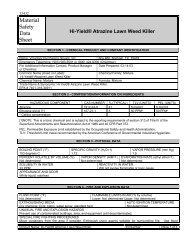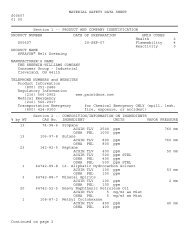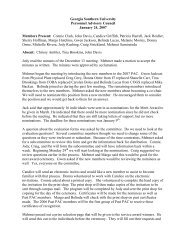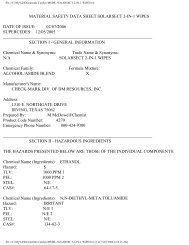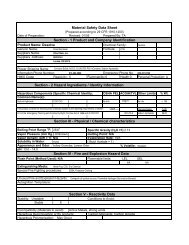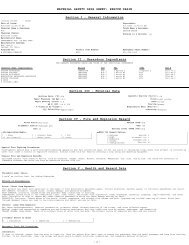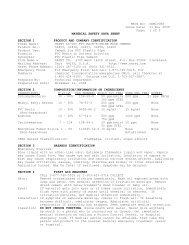Pyridine, anhydrous, 99.0%,< 50 ppm water - services
Pyridine, anhydrous, 99.0%,< 50 ppm water - services
Pyridine, anhydrous, 99.0%,< 50 ppm water - services
Create successful ePaper yourself
Turn your PDF publications into a flip-book with our unique Google optimized e-Paper software.
Viscosity: 0.95 mPa s 20 deg CBoiling Point: 115 deg CFreezing/Melting Point:-42 deg CAutoignition Temperature: 900 deg F ( 482.22 deg C)Flash Point: 17 deg C ( 62.60 deg F)Decomposition Temperature:Not available.NFPA Rating: (estimated) Health: 3; Flammability: 3; Reactivity: 0Explosion Limits, Lower: 1.8%Upper: 12.4%Solubility: Miscible in <strong>water</strong>. Volatile in steam.Specific Gravity/Density:.9700Molecular Formula:C5H5NMolecular Weight:79.10Section 10 - Stability and ReactivityChemical Stability: Stable under normal temperatures and pressures.Conditions to Avoid: Ignition sources, excess heat, electrical sparks, exposure to flame.Incompatibilities with Other Materials: Acids; acid chlorides; oxidizing agents;chloroformates; bromine trifluoride; mixtures with formamide, iodine, and sulfur trioxide,chlorosulfonic acid, chromic acid, maleic anhydride, sulfuric acid, perchromates, and dinitrogentetroxideHazardous Decomposition Products: Nitrogen oxides, carbon monoxide, carbon dioxide,cyanide fumes.Hazardous Polymerization: Will not occur.Section 11 - Toxicological InformationRTECS#:CAS# 110-86-1: UR8400000LD<strong>50</strong>/LC<strong>50</strong>:CAS# 110-86-1:Dermal, guinea pig: LD<strong>50</strong> = 1 gm/kg;Draize test, rabbit, skin: <strong>50</strong>0 mg/24H Mild;Inhalation, rat: LC<strong>50</strong> = 28<strong>50</strong>0 mg/m3/1H;Oral, mouse: LD<strong>50</strong> = 1<strong>50</strong>0 mg/kg;Oral, rat: LD<strong>50</strong> = 891 mg/kg;Skin, rabbit: LD<strong>50</strong> = 1121 mg/kg;Carcinogenicity:CAS# 110-86-1:IARC: Group 3 carcinogenEpidemiology: No information available.Teratogenicity: <strong>Pyridine</strong> caused muscle/skeletal effects when injected into developing chickensbut was not teratogenic in frogs at sublethal doses. The relevance of these studies to humanreproduction is unclear.Reproductive Effects: No information available.Neurotoxicity: No information available.Mutagenicity: <strong>Pyridine</strong>'s mutagenicity potential is equivocal. It was reported to be both positiveand negative in Salmonella typhimurium strains. It was not mutagenic in tests for chromosomehttps://fscimage.fishersci.com/msds/91562.htm (4 of 7) [2/15/2002 1:51:45 AM]



